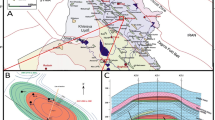Abstract
Samples were collected from an oil polluted site in Niger-delta, Nigeria. Gas chromatographic analyses carried out on the samples revealed an abundance of n-alkanes within the n-C8–n-C23 region. The pristane/phytane ratio of 5.70 obtained for the samples depicted a plant/terrestrial source input and a possible oxic depositional environment. The n-C17/pristane and n-C18/phytane ratios of 2.80 and 2.77, respectively, suggested that the spilled oil was only slightly weathered, as corroborated by the presence of peaks in the aromatic hydrocarbon fingerprints. The polycyclic aromatic hydrocarbon (PAH) fractions showed that the hydrocarbon fractions might have undergone combustion and/or that there was bush burning at the site prior to the oil spill incidence. This is supported by the abundance of high-molecular-weight PAHs which are pyrogenic in nature. High molecular weight PAHs are products of the combustion of petroleum or its products. The phenanthrene/anthracene ratio of 0.95, fluorathene/pyrene ratio of 2.23 and the ∑ (other three to six ringed PAHs)/∑ (five alkylated PAHs) ratio far greater than unity (4.10) also affirm this. On the other hand, the benzo (a) anthracene to chrysene ratio of 0.24 confirms the petrogenic origin of the spilled oil because chrysene which is highly abundant is a fossil PAH.
Similar content being viewed by others
References
Bence, A. E., Kvenvolden, K. A., & Kennicutt, M. C., II. (1996). Organic geochemistry applied to environmental assessments of prince William sound, Alaska, after the Exxon Valdez oil spill – a review. Organic Geochemistry, 24, 7–42.
Benlahcen, K. T., Chaoui, A., Budzinski, H., Bellocq, J., & Garrigues, P. H. (1997). Distribution of Sources of PAHs in some Mediterranean Coastal Sediment. Marine Pollution Bulletin, 34(5), 298–305.
Bjǿeseth, A. (1985). Sources of emissions of PAHs. In A. Bjǿeseth, & T. Ramdahl (Eds.) Handbook of polycyclic aromatic hydrocarbons (pp. 1–20). New York: Marcel Dekker.
Cinta, B., Dolors, P., Monstserrat, S., & Joan, A. (2000). The Aegean sea oil spill 2: T emporal study of the hydrocarbons accumulation in Bivalves. Environmental Science & Technology, 34(9), 5067–5075.
Hunt, J.M. (1996). Petroleum geochemistry and geology pp. 7–47, 415–437. New York: Freeman.
Kaplan, I.R. & Galperon, Y. (1996). How to recognize a hydrocarbon fuel in the environment and estimate its age of release. In T. J. Bois II & B. J. Luther (Eds.), Groundwater and soil contamination: Technical preparation and litigation management. Wiley, New York.
Osuji, L. C., Udoetok, I. A., & Ogali, R. E. (2006). Attenuation of petroleum hydrocarbons by weathering: A case study. Chemistry & Biodiversity, 3, 422–433.
Page, D. S., Boehm, P. D., Douglass, G. S., Bence, A. E., Burns, W. A., & Mankiewiczl, P. J. (1996). The natural petroleum hydrocarbon background in subtidal sediments of Prince William Sound, Alaska, USA. Environmental Toxicology and Chemistry, 15(8), 1266–1281.
Stout, S. A., Uhler, A. D., McCarthy, K. J., & Emsbo-Mattingly, S. (2002). Chemical fingerprinting of hydrocarbons. In B. L. Murphy, & R. D. Morrison (Eds.) Introduction to environmental forensics (pp. 137–260). London: Academic.
Udoetok, I. A. (2005). Composition and distribution of petroleum hydrocarbons of Idu-Ekpeye Oil spillage site in Niger-Delta, Nigeria. MS thesis, University of Port Harcourt, Nigeria.
Wang, Z., & Fingas, M. F. (2003). Development of oil hydrocarbon fingerprinting and identification techniques. Marine Pollution Bulletin, 47, 423–452.
Wang, Z., Fingas, M. F., & Page, D. S. (1999). Oils spill identification review. Journal of Chromatography, 843, 369–411.
Author information
Authors and Affiliations
Corresponding author
Rights and permissions
About this article
Cite this article
Udoetok, I.A., Osuji, L.C. Gas chromatographic fingerprinting of crude oil from Idu-Ekpeye oil spillage site in Niger-delta, Nigeria. Environ Monit Assess 141, 359–364 (2008). https://doi.org/10.1007/s10661-007-9902-0
Received:
Accepted:
Published:
Issue Date:
DOI: https://doi.org/10.1007/s10661-007-9902-0




